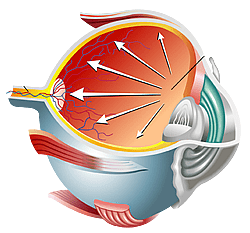
As a referral center for the evaluation and treatment of glaucoma, Berks Eye Physicians & Surgeons in Berks County, Pennsylvania brings to you the most advanced, proven methods of glaucoma diagnosis as well as comprehensive treatment options.
Dr. Tellez and Dr. Michael C. Izzo are fellowship-trained glaucoma specialists and surgeons. All of our physicians provide glaucoma patients with individualized care plans and personalized one-on-one attention. Whether the care plan calls for medication, surgery or simply monitoring exams, your doctor will focus on you as a person and offer the best treatment choices tailored to your individual needs. Our goal is to protect your vision and quality of life and to care for you in the warm and pleasant environment that distinguishes Berks Eye Physicians & Surgeons.
What Is Glaucoma?
Glaucoma is a group of eye disorders that share the common feature of optic nerve damage. This damage is usually, but not always, caused by elevated fluid pressure within the eye. When pressure inside the eye increases, the optic nerve loses nerve fibers and blind spots can develop, resulting in loss of peripheral or even central vision. The higher the pressure, the greater the chance of damage to the optic nerve. Glaucoma is a leading cause of irreversible visual impairment and blindness in the United States and worldwide.
What Is The Optic Nerve?
 The optic nerve is the “cable” that exits from the back of the eye and carries the images we see to the brain. It is made up of millions of nerve fibers that start in the retina and end up in the visual processing centers of the back of the brain (the occipital cortex). A healthy optic nerve is necessary for good vision. When the fibers of the optic nerve are damaged in glaucoma, loss of the side vision can develop, which can progress to blindness.
The optic nerve is the “cable” that exits from the back of the eye and carries the images we see to the brain. It is made up of millions of nerve fibers that start in the retina and end up in the visual processing centers of the back of the brain (the occipital cortex). A healthy optic nerve is necessary for good vision. When the fibers of the optic nerve are damaged in glaucoma, loss of the side vision can develop, which can progress to blindness.
Who Is at Risk for Glaucoma?
As with many other diseases, certain individuals may be more at risk of developing glaucoma than others. During your glaucoma evaluation, your ophthalmologist will collect a good deal of information to help determine your glaucoma risk factor profile. Below are some of the major risk factors for glaucoma.
- A family history of glaucoma (especially first-degree relatives)
- African or Hispanic (especially Mexican) ancestry
- Anyone over age 60 or African descent over age 40
- High myopia (nearsightedness)
- Past injuries to the eyes
- High blood pressure
- Elevated intraocular pressure
- Central corneal thickness less than 0.5 mm
What Causes Glaucoma?
Aqueous humor is a clear, watery fluid inside the eye that nourishes the cornea, iris, lens, and maintains intraocular pressure (IOP). This liquid is not part of the tears on the outer surface of the eye. You can think of the flow of aqueous fluid as a sink with the faucet turned on all the time. If the “drainpipe” gets clogged, water collects in the sink and the pressure builds up. If the drainage area of the eye (drainage angle) is blocked or does not work properly, the fluid pressure inside the eye may increase, which can damage the optic nerve. The result of this pressure increase as it pushes against the nerve is constricting (or loss of) the side vision.
 1802 Paper Mill Road, Wyomissing, PA 19610
1802 Paper Mill Road, Wyomissing, PA 19610

